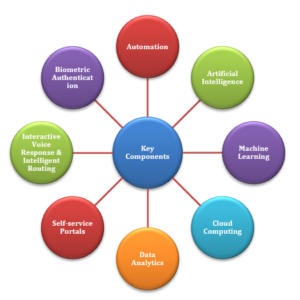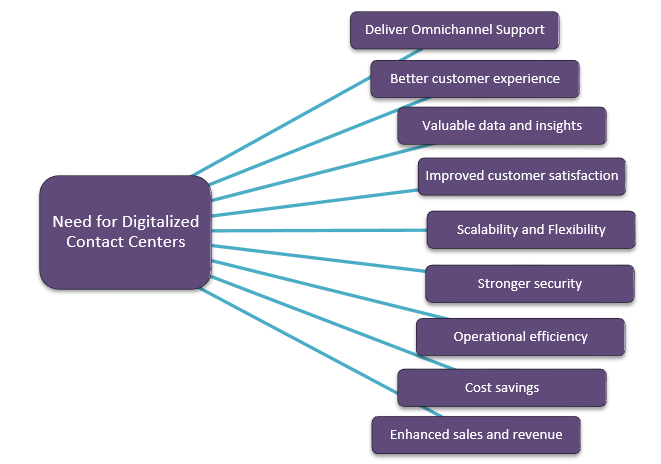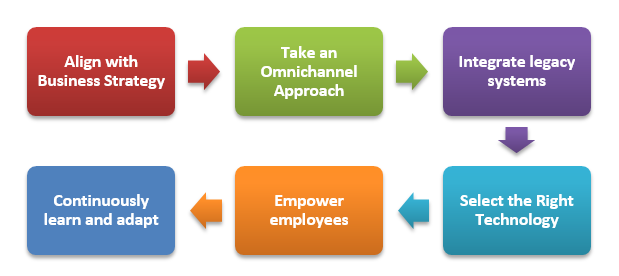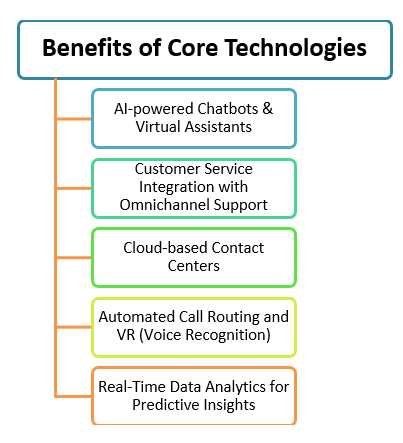Introduction
Digital transformation has changed the face of every industry that reshapes how companies operate, emphasizing innovation and agility. Businesses are embracing digital transformation in contact centers to gain the ultimate digital experience and meet the ever-evolving consumer demands. This article emphasizes how digitalized contact center is pivotal for futuristic, modern businesses. It explains the transformation of contact centers to advanced, cloud-based centers, highlighting their key components, driving factors, necessities/ benefits, transformation process and the core technologies involved. It’s a guide to understanding how these centers act more than just call response hubs; boost customer satisfaction and provide efficient support across multiple channels.
What is Digital Transformation in Contact Centers?
The customer service domain is rapidly evolving, with contact center services at the forefront, steering businesses toward a future where every customer interaction counts. A digital transformed contact center is an omnichannel hub, supported by automation and other digital technology to provide a more streamlined service to customers. It can overcome the stigma of an inefficient call center by transitioning from an on-premise contact center setup to a cloud-based operation, leveraging technologies like Artificial Intelligence in order to offer highly personalized support across various channels. The key components involved in digital transformation are,

By adopting a contact centre digital strategy, brands can discover, gather, and analyse their customer data knowledge base in a new approach, providing them fresh insights throughout the entire customer journey. The seamless blend of digital tools and human empathy improves customer experiences. Also, it boosts operational agility, creating contact centre services a cornerstore for firms aiming to improvise their consumer engagement and retention.
What Drives the Digital Transformation in Contact Centers?
The COVID-19 pandemic acted as a main catalyst for digitalized contact centers, forcing organisations to rapidly adapt to advanced technological solutions. With lockdowns and social distancing disrupting traditional operations, firms had to accelerate their shift from traditional to digital contact centers. This changeover was considered crucial in handling the surge in customer service demands while also upholding satisfaction and efficiency.
How COVID-19 has accelerated digital change?- This epidemic underscored the significance of digital readiness, pushing organisations to embrace online communication, automated customer service, and remote work. The sudden surge in service enquiries led to higher dropout rates and customer discontent, driving firms to implement AI-powered chatbots, cloud-based solutions, and omnichannel support to facilitate seamless interactions.
How COVID has shaped the Digital Future?- This pandemic permanently restructured digital strategies across industrial sectors, proving that this transformation is a survival necessity more than a competitive advantage. Firms that have integrated AI automation and data-driven insights have gained significant improvements in customer experiences and operational efficiency. Moving ahead, the lessons learned from the crisis will continue to shape technical improvements, ensuring that firms stay future-ready, agile, and customer-driven in an ever-changing digital context.
Why is this transformation more significant than ever? – Staying competitive in today’s digital economy requires changing technical advancements. Firms that implement digital technologies can optimize their business operations, drive innovation, and enhance customer interactions, gaining substantial benefits over their competitors who rely on outdated systems. The ability to quickly adapt to market changes and customer expectations will define success in the future, making digital transformation a must-have strategy for expansion and resilience.
Necessity of Digital Transformation in Contact Centers for Future
Digital transformation is revolutionizing how contact centers operate and manage customer interactions. Following are the aspects that define the necessity of digital transformation in contact centers.

- Deliver Omnichannel Support: Digital transformation give customers the experience they want, on any channel (social media, live chat, chatbots, voice calls and email), when they want it. Customers demand a consistent experience across all platforms, and they expect brands to meet them on the channels they prefer. Omnichannel assistance in contact centres addresses this issue by offering a consistent experience, allowing consumers to transition effortlessly from one channel to another without losing context.
- Better customer experience: Customers will never have to wait for service with chatbot technology and self-service portals; with intelligent routing, they can be confident that they will always be connected to the agent best suited to resolve their problem or answer their question; and with omnichannel orchestration, they will be able to move seamlessly from one contact channel to another without having to repeat their issue. Improved customer experience is achieved through personalised care, faster issue resolution, and seamless interactions.
- Valuable data and insights: Gathering and analysing customer contact data across several channels can be difficult. Contact centres combine this data, providing important insights into customer behaviour and preferences that may be used to guide corporate strategy and improve service offerings. By analysing patterns and client feedback, firms can find areas for improvement and make better decisions.
- Improved customer satisfaction: Contact centres cater to a variety of consumer preferences and expectations. They boost client happiness by providing various communication channels, letting them to select the most convenient one for their needs, resulting in more effective and fulfilling interactions. They also handle issues on the first encounter, which improves client happiness and loyalty.
- Scalability and Flexibility: Analytics-based forecasting will give firms insight into future demand, while cloud computing will make it simple to scale up or down as needed to meet changing business demands.
- Stronger security: Biometric authentication, enabled by AI, protects fraudsters and other unauthorised individuals from accessing confidential customer information while also allowing customers to readily authenticate their identity.
- Operational efficiency: Contact centres automate and intelligently route client contacts across channels. This guarantees that consumers are swiftly directed to the proper agent or resource. This efficiency minimises wait times and increases the number of clients serviced, as fast customer service has a substantial impact on customer retention and satisfaction.
- Enhanced sales and revenue: Contact centres can increase sales and revenue streams by allowing for cross-selling and upselling opportunities via direct customer contact across many touchpoints. Agents can use client interaction history to provide relevant additional items or services, improving customer value and revenue.
- Cost savings: Automation and outsourcing improve efficiency while reducing the demand for physical infrastructure and manpower. Consolidating services and implementing cloud-based solutions results in decreased overhead costs and the capability to scale operations in response to demand.
Digital Transformation Process
The digital transformation of contact centers involved the following processes,

Step 1: Align with Business Strategy- To ensure seamless integration, align your contact centre transformation with your company goals and customer experience plan.
Step 2: Take an Omnichannel Approach– Engage clients on their preferred platforms by incorporating digital channels that match audience demographics, hence increasing accessibility and happiness.
Step 3: Integrate legacy systems- To avoid data loss and ensure operational continuity, new technologies must be compatible with old systems.
Step 4: Select the Right Technology- Instead of adopting technology for its own sake, invest in digital technologies that improve the customer experience and streamline employee procedures.
Step 5: Empower employees- Provide training and real-time data to assist agents in optimising new technology, allowing them to provide empathic and efficient customer care.
Step 6: Continuously learn and adapt- Use real-time data and customer insights to fine-tune strategy, optimise operations, and guarantee that service quality continues to improve.
Benefits of Core Technologies that Shaping the Future of Contact Centers
Digital transformation in contact centers is made possible through the use of a few specific types of technology. They are,

1. AI-powered Chatbots & Virtual Assistants
- AI-powered chatbots utilise natural language processing to assist clients, handle issues, and escalate complex situations to human agents.
- Automating common processes lowers operational costs, improves efficiency, and enables contact centres to handle more requests with faster response times.
- These tools let businesses to provide 24/7 customer assistance with rapid, consistent, and dependable responses, leading to increased service availability and satisfaction.
- Virtual assistants analyse client data to develop marketing strategies and enhance the customer experience.
- Automating basic enquiries allows human agents to focus on more complicated activities, increasing operational efficiency.
2. Customer Service Integration with Omnichannel Support
- Omnichannel integration provides seamless customer service across several channels, including phone, email, social media, and live chat.
- By consolidating contacts into a single display, agents may address issues more effectively and avoid repeating customer information.
- Enhances client happiness and retention by delivering personalised experiences across all channels.
- Meeting customer expectations for seamless channel transitions provides businesses with a competitive advantage.
- Omnichannel platforms offer important customer data, enabling firms to discover trends, predict needs, and enhance marketing and sales strategies.
3. Cloud-based Contact Centers
- Cloud-based contact centres provide agents with greater flexibility and scalability as they may operate remotely. It minimises operational costs while simplifying remote team administration and providing global coverage.
- Businesses may simply scale operations to accommodate client demand, seasonal spikes, and expansion.
- Advanced features such as real-time monitoring, analytics, and reporting enhance performance and efficiency.
- Collaboration tools facilitate communication across distributed teams, resulting in improved customer service.
4. Automated Call Routing and VR (Voice Recognition)
- AI-powered call routing connects clients to the appropriate agent or department, lowering wait times and increasing efficiency.
- Voice recognition technology accurately filters and routes calls by identifying consumer demands through spoken inputs.
- These technologies reduce human error, optimise operations, and enable agents to resolve issues rather than transfer calls.
- Faster request interpretation enhances service quality and customer experience.
- Automated systems track call patterns, handling times, and satisfaction levels, providing operational insights for managers to improve processes and training.
5. Real-Time Data Analytics for Predictive Insights
- Predictive analytics uses historical data and machine learning to predict client behaviour and trends.
- Contact centres may improve satisfaction and loyalty by anticipating call volume, identifying at-risk consumers, and providing proactive support.
- Businesses can optimise resource allocation by forecasting peak call periods, staffing accordingly, lowering wait times, and minimising call abandonment.
- Predictive insights help discover trends, bottlenecks, and improve personalised marketing and customer care by finding upsell possibilities and anticipating client demands.
- Using a proactive strategy improves customer relationships and drives long-term business growth.
Conclusion
The future of contact centre technology is not just embracing new tools, but also reimagining customer service as a key strategic asset for business expansion. As time flies on, the integration of Artificial Intelligence, machine learning, and cloud technologies will further transform contact centres into more dynamic and customer- centric hubs. These advancements offer highly personalised, well-organized, and intelligent consumer encounters, enabling brands to stay ahead in this competitive market.
At KDATAAI, we assist you in this transformative journey, providing cutting-edge AI-powered solutions that allow contact centres to exceed customer expectations. With KDATAAI, firms can harness the power of AI automation, Real-time data analytics, and omnichannel support in order to deliver excellent service experiences. The right blend of digital technology and human empathy that KDATAAI offers will be instrumental in determining the success of digitalized contact centers in the near future.
Explore our services and create an impressive contact center experiences with KDATAAI!
